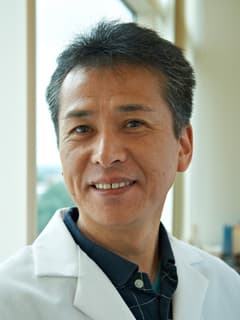HOW CAN WE HELP YOU? Call 1-800-TRY-CHOP
In This Section

Dr. Koyama's research focuses on Hereditary Multiple Exostoses (HME), a genetic disorder that causes the development of multiple benign tumors on the surface of the metaphyses of long bones. Based on his extensive knowledge of the normal processes of skeletal development and growth, Dr. Koyama's research aims to clarify the molecular mechanisms of HME formation and growth.
Bio
Dr. Koyama's research program focuses currently focuses on synovial joint development, Hereditary Multiple Exostosis, and temporomandibular joint development and postnatal maintenance.
Specifically, with respect to synovial joint development, the first overt sign of joint development is the appearance of a layer of closely-packed mesenchymal non-chondrogenic cells referred to as interzone. Dr. Koyama and his team have discovered its important roles for joint formation.
The team has also studied several congenital conditions including HME that affects children and young adults. Based on their extensive knowledge of the normal processes of skeletal development and growth, Dr. Koyama and his colleagues would like to clarify the molecular mechanisms of HME formation and growth.
Dr. Koyama also investigates temporomandibular joint (TMJ) development and postnatal maintenance. Mandibular condylar cartilage is essential for functioning of the TMJ and its congenital or acquired aberrations can cause disease, including early onset osteoarthritis. Dr. Koyama and his research team demonstrated that hedgehogs signaling is essential to condylar growth, both structural and functional.
Education and Training
DDS, Matsumoto Dental University, Japan, 1985
PhD, Okayama University, Japan (Developmental Biology), 1993
Titles and Academic Titles
Scientist, Biomedical Research Program in Pediatric Orthopaedics
Research Associate Professor
Professional Memberships
American Society for Bone and Mineral Research, 2005-
American Association of Dental Research, 2010-